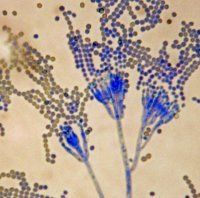Tremorgenic mycotoxins fit into two classes that act at the level of the central nervous system. The first class are mycotoxins that cause paralysis and respiratory arrest, e.g., Citreoviridin; and the second class causes true tremors. The tremorgenic mycotoxins are indole-diterpene alkaloids.
Both groups are discussed in this short review (Ciegler and Vesonder, 1976; Clark et al, 2003; Zhang et al, 2004). The true tremorgens are subdivided based upon the nitrogen content, e.g., 1, 3 or 4 such atoms.
Citreoviridin is produced by Penicillium citreonigrum, toxicarium and ochrosalmoneum and Aspergillus terreus (Fermentek, 2010). It is neurotoxic, causing paralysis and respiratory arrest in canines (Ciegler and Vesonder, 1976). The toxin is present in rice in Asia and maize in the U.S. (Sun, 2010; Wicklow et al, 1988). It is suspected of causing a beriberi-like illness in Japan and China where rice is contaminated with the mycotoxin.
Chronic exposure to contaminated cereals has been suggested as a cause of Keshan disease in China (Sun, 2010). Its toxicity is derived from an inhibition of an enzyme--ATP triphosphatase of the mitochondrial membrane (Sayood et al, 1989; Gause et al, 1981: Linnett et al, 1978). To my knowledge, citreoviridin has not been detected in water-damaged buildings (WDB). However, since Aspergillus terreus is common to WDB, citreoviridin may be present.
In addition to producing Aflatoxins, Aspergillus flavus has an indole-diterpene gene cluster that produces thee termorgens aflatrem and β-aflatrem. These genes have a 64-70% amino acid sequence similarity with the paxilline genes of Penicillium paxilli (Zhang et al, 2004).
The aflatrem mycotoxins contain a single nitrogen atom located in the indole ring. These mycotoxins, like all others in the single nitrogen group tremorgens, cause severe tremors and oxidative bursts in animals and humans. They cause symptoms ranging from mental confusion to tremors, seizures and death.
Livestock have neurologic diseases classified as staggers syndrome from eating contaminated silage. These mycotoxins pose significant agricultural and health problems in both animals and humans (Valdes, et al, 1985).
The pharmacological action of aflatrem is on gamma-aminobutyric acid neurotransmission.
Aflatrem is an agonist of GABA causing a stimulation of these receptors, which in return leads to tremors. One of the major sites of action is the hippocampus (Valdes et al, 1985; Yao et al, 1989; Selala et al, 1989). A single low acute dose to rats induced neuronal degeneration in the hippocampus neurotransmitter systems, and, therefore, represents a long-term health threat (Valdes et al, 1985).
Aspergillus flavus has been identified in WDB and is also one of fungi on the U.S. EPA ERMI test. Although Aflatrem has not been demonstrated in WDB, it is most likely present because aflatoxin B1 has been found in these environments (Bloom et al, 2009).
Penitrem (PA) mycotoxins (A-E) are produced by Penicillium crustosum, cyclopium and commune. They are commonly present in various spoiled foods (meats, nuts, cheeses, eggs, fruits) and cereals (Gupta, 2007). Penitrem A blocks an inhibitor of large conductance Ca(2+)-sensitive K+ channels BK (Ca2+), affecting vasodilatation (Namiranian K, et al. 2010; Burbouse et al, 2010).
In addition, Penitrem A is neurotoxic. I.P. Injection on postnatal days 3, 6 and weeks in mice caused noticeable tremors and loss of cerebellar Purkinje cells, particularly in the youngest mice (Lu et al, 2008).
Additionally, Intraventricular and I.P. acute administration of PA in rats caused a transient alteration of EEG lasting 3 to 7 days. In severe cases, neuromuscular disturbances were maintained at day 7. Coronal sections of the brain showed dose related injuries in the cerebellum and massive degeneration of Purkinje cells (Breton et al, 1998).
Moreover, I.P. acute administration of PA to mice resulted in depressed exploratory reflex behavior and significant neuro motor depression (Soboka et al, 1978). Both canine and human poisoning from contaminated food have been reported (Eriksen et al, 2010; Lewis et al, 2005).
Finally, the hepatic metabolism of PA by rat hepatocytes resulted in at least five metabolites that are more hydrophobic than PA (Moldes-Anaya et al, 2009). Thus, the toxic effect on Ca and K channel and central nervous system of humans and animals may result from any or all of the parent compound and its metabolites.
Verruculogen is produced by Aspergillus species, the most common is A. fumigatus. It is also produced by several species of Penicillium: piscarium, verruculosum, janthinellum and other possible species (Patterson et al, 1981). Verruculogen blocks Ca2+-activated K+ channels and inhibits GABAA receptor functions (Gant et al, 1987; Aoki and Baraban, 2000). The mycotoxin also alters the electrophysiological properties of human nasal epithelia cells (Khoufache et al, 2007). Both airborne and clinical isolates of A. fumigatus produce Verruculogen (Kosalec et al, 2005).
Of interest, species of Aspergillus, Penicillium and Fusarium
have been isolated in uranium mines and saw mills and demonstrated to produce a variety of mycotoxins, including Verruculogen (Land et al, 1987; Sram et al, 1993). The case of the uranium miners throat swab samples with subsequent mold cultures revealed mutagenicity of detected mycotoxins: mycophenolic acid, Aflatoxin B1, G1, citrinin, citreoviridin and sterigmatocystin.
In the sawmills, both fumitremorgin C and verruculogen were identified which are probably involved in the acute phase of wood-trimmers disease.
It is important to understand the A. fumigatus consists of at least 24 biosynthetic families which produce the following metabolites: fumgatins, fumigaclavines, fumiquinazolines, trypacidin, monomethylsulochrin, fumagillins, gliotoxin, pseurotins, chloroanthraquinones, fumitremorgins, verruculogen, helvolic acids and pyripyropenes (Frisvad, et al, 2008).
Since A. Fumigatus causes aspergillosis in immune-incompetent and competent individuals, its multiple toxins must be considered in this disease.
Other Tremogens
Below is a list of additional Tremorgenic mycotoxins. They cause stagger syndromes in live stock and similar symptoms in dogs and humans. Their mode of action on the nervous system is as described above: Calcium-potassium channels and GBAA receptors.
Paxilline, lolitrem B, territrems, paspaline, pasapultrem A and C, tryptoquivaline, tryptoquivalone, fumitermogen B and verrucosindin.

